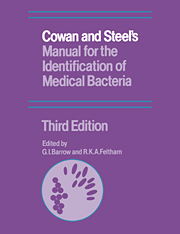Book contents
- Frontmatter
- Contents
- Foreword
- Preface to the first edition
- Postscript
- Preface to the second edition
- Preface to the third edition
- List of contributors
- Introduction
- 1 Classification and nomenclature
- 2 Culture media: constituents and sterilization
- 3 Principles of isolation
- 4 Bacterial characters and characterization
- 5 Theory and practice of bacterial identification
- 6 Characters of Gram-positive bacteria
- 7 Characters of Gram-negative bacteria
- 8 Taxonomy in theory and practice
- 9 Bacterial identification by cards
- 10 Bacterial identification by computer
- 11 Quality control in microbiology
- Appendices
- References
- Index
11 - Quality control in microbiology
Published online by Cambridge University Press: 15 December 2009
- Frontmatter
- Contents
- Foreword
- Preface to the first edition
- Postscript
- Preface to the second edition
- Preface to the third edition
- List of contributors
- Introduction
- 1 Classification and nomenclature
- 2 Culture media: constituents and sterilization
- 3 Principles of isolation
- 4 Bacterial characters and characterization
- 5 Theory and practice of bacterial identification
- 6 Characters of Gram-positive bacteria
- 7 Characters of Gram-negative bacteria
- 8 Taxonomy in theory and practice
- 9 Bacterial identification by cards
- 10 Bacterial identification by computer
- 11 Quality control in microbiology
- Appendices
- References
- Index
Summary
From the beginning, this Manual has preached consistently not only about the importance of pure cultures for identification but also of the need for standardization of test methods both within and between laboratories. We reinforce these views here with a brief outline of the current concepts of quality control and laboratory proficiency which must be understood and put into practice for good identification procedures to succeed. As before, we emphasize the importance of controlling characterization tests with organisms known to give positive and negative results; the test organisms recommended are given in Appendix D together with media and conditions suitable for their propagation short-term and storage.
Laboratory quality control
Quality control can be regarded as the continual monitoring of equipment, reagents and working practices as well as the provision of training with specified details of laboratory methods and procedures to ensure proficiency. The lack of test reproducibility both within and between laboratories, discussed in previous editions of this Manual, has now been well documented (Sneath & Johnson, 1972; Lapage et al., 1973; Sneath, 1974; Sneath & Collins, 1974; Snell, DeMello & Phua, 1986). Variation in test results between laboratories may be due to differences in the sensitivities of the methods used. Such differences are of considerable practical importance as the results given in the diagnostic tables and keys may be applicable only if the methods stated are used. This applies also to micromethods and diagnostic kits.
- Type
- Chapter
- Information
- Publisher: Cambridge University PressPrint publication year: 1993



